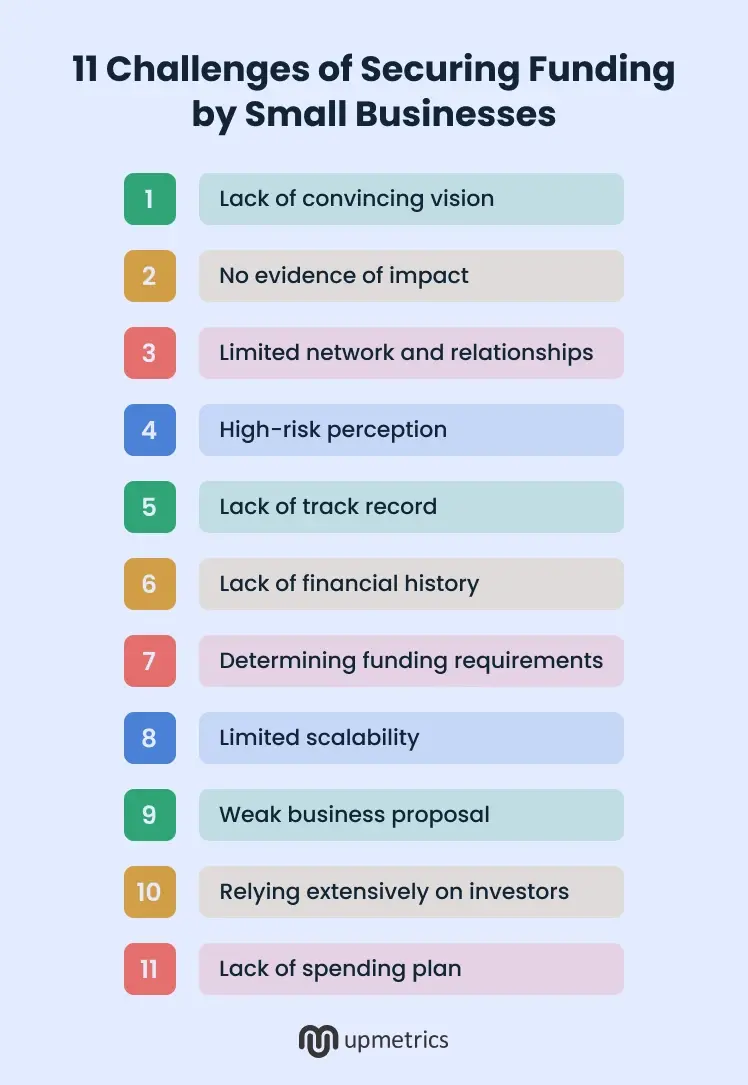Raising capital sounds simple—until you’re the one doing it.
You need money to grow, but investors want proof you’ve already grown. Choose a traditional path, and banks demand collateral you don’t have.
Every funding source comes with its own set of rules, and somehow, you never seem to fit perfectly into any of them.
These funding challenges in business aren’t just frustrating—they can stall your progress or stop your business from ever taking off.
In this blog post, we have lined out challenges you may face while raising funds. Read along and you will know how to overcome them.
11 Challenges of Securing Funding by Small Businesses
Securing funding is rarely straightforward. From struggling with scalability to having a limited financial history, several challenges can make it difficult to raise capital—there are numerous funding challenges in a business.

Let’s explore them.
1. Lack of convincing vision
Can you concisely and impactfully convey your business vision in less than 30 seconds?
If not, you will struggle to convince investors, and for that matter, even banks to lend you money.
You see when you don’t have clarity and conviction in your business vision, you simply can’t expect the investors to be on the same page as you.
So first step?
Refine your vision until it’s crystal clear. If you don’t have one, build a giant, bold, almost crazy vision—one that excites people. But keep it grounded in reality.
At the same time, focus on delivering a compelling value proposition to investors. They don’t care about your technology or product features as much as they are interested in what value they gain by investing in your business.
Once you approach your pitch focusing on vision and value, the reason for rejection at least won’t be a lack of investor interest.
2. No evidence of impact
Banks won’t fund pre-revenue businesses. And while investors might, they won’t back a business that only exists on paper.
Meaning, you need to demonstrate traction to convince investors of your potential. This could be pre-orders, pilot customers, strong user interest, partnerships, or waitlist signups—anything that shows real demand.
If you don’t have revenue yet, focus on early validation. This includes demonstrating market research, running product tests, or making a small-scale launch.
At its core, investors want to see that people want what you’re building and are willing to pay for it.
3. Limited network and relationships
When they said networking is everything, they weren’t exaggerating.
As a startup founder, you need to actively build relationships with investors, industry leaders, and fellow entrepreneurs.
You see, investors are far more likely to back businesses they trust or get introduced to, rather than those reaching out blindly.
If you’re fairly new to the startup world, join startup communities, build social visibility on Twitter and LinkedIn, and attend as many relevant events as possible.
The small elevator pitch you make at such events will open doors that the cold outreach never will.
4. High-risk perception
Investors hesitate to invest in businesses that face legal uncertainties, require complex approvals, or struggle to differentiate from competitors.
If your startup is one of them, investors may consider them high risk.
Now, I am not saying that investors would run at the first sight of risk. They are prepared for the risk that’s calculated and well-planned.
To win their confidence, you need a solid team with relevant industrial experience, a well-mapped business plan, and a competitive edge that’s too good to ignore.
The key isn’t eliminating risk—but showing how you will navigate it.
5. Lack of track record
According to a report by HBS, founders of a previously successful business have a 30% chance of success with their next venture.
Now, you may have all the grit and passion needed to lead a business. However, lenders are likely to hesitate if you don’t have relevant experience, industry expertise, or a proven track record to run a business.
If you’re relatively new with no direct expertise, the best way to build credibility is by surrounding yourself with the right people. By this I mean, bring the advisors, co-founders, or team members who have relevant industry experience.
Show that you’re taking classes to upskill yourself. Or better talk about the mentor that’s helping you bridge the knowledge gap.
The idea is to show that you have the drive and adaptability to make the business successful.
6. Lack of financial history
Securing funding may get difficult, without a credit history, financial statements, or proof of revenue.
After all, lenders and investors need some sort of financial history to assess risk.
Having clearly laid projections or some early sales data brings in that much-needed conviction necessary for them to trust your business.
Consider securing subscription sign-ups, supplier agreements, partnership contracts, or service retainers to show future cash flow potential.
These commitments indicate real demand and reassure investors that your business has revenue on the horizon.
7. Determining funding requirements
Whether you’re seeking a loan or asking for funds from investors—you must have a clear figure for your funding requirements.
Ask too little and you would be scrambling for cash to run everyday operations.
Ask too much and you will be struggling with higher interest payments. Or worse you may give away excessive equity and control.
So before anything else, get to know your finances. Account for various progressive and aggressive scenarios while factoring in operational costs, scalability needs, and potential setbacks.
Understand how much funding is essential to keep you afloat till you achieve break even.
And most importantly, have your terms well-defined—know how much equity you’re willing to give up and at what valuation.
8. Limited scalability
Investors invest in high-growth scalable business ideas. Businesses that can grow without increasing costs at a higher rate.
Sometimes the founders fall so in love with the product or tech that they undervalue the practicality of scaling within their market.
That said, if your revenue growth is directly tied to increasing workforce or physical infrastructure, investors would hesitate. Such business models, although successful at a small scale, require continuous capital injections to grow sustainably.
To build scalability, focus on reducing manual processes and location-dependent operations. Expand your available market size and optimize operations to handle growth efficiently.
If you can show that your business can capture a larger market without logistical constraints and expensive overheads, this funding challenge solves itself.
9. Weak business proposal
Yes, you have a killer business idea. Even an undeniably strong market, demand, and scalability.
But does your proposal reflect that? Does it convey information necessary to make a decision, and much so in a manner that favors you?
More often than not, founders approach investors and lenders with half-baked business proposals.
It’s either missing key financials or has vague execution plans that would result in investors losing interest instantly.
Take a step behind and work on your documents, whether it’s a business plan, pitch deck, or financial projections. Gather necessary information and present it in an absorbable manner. And most importantly demonstrate why your business is a great investment opportunity for the lender.
10. Relying extensively on investors
Headlines of startups securing billion-dollar funding might make it seem like investor money is the only way to grow. But that’s not the truth.
Sometimes an investor rejects a business proposal even when it checklists everything they are looking for.
And sometimes, despite the potential of your idea, it might not be a lucrative opportunity for investors.
As Codie Sanchez, the founder of Contrarian Thinking and Main St.Hold says, raising money is a tool, not the end goal.

Instead of chasing unrealistic growth, it’s better to explore alternative funding options that offer quick access to capital. This way you can kickstart business operations, achieve milestones, and grow your business while not struggling with liquidity.
And who knows, one day investors might find your post-revenue business investable and lucrative, opening opportunities for further funding.
11. Lack of spending plan
Demanding $10 million dollars isn’t wrong. Not showing how you plan to utilize that funding is what’s stopping lenders.
Do you plan to launch a production unit or do you plan to hire on scale? Are you going to spend funding on office space or will you use the money to scale marketing?
Now, I am not saying plan every penny you would be receiving. Just be transparent and offer a clear, strategic breakdown of where the funds will go.
Lenders want to know how their money will be utilized and whether it will be put to good use.
That’s a round-up of the most common funding challenges faced by entrepreneurs as they venture out.
How to prepare yourself for funding challenges
The funding challenges in business shouldn’t stop you from trying your best. A little prep and a lot of practice can take you closer to securing the capital you need.
Here’s how:
1. Network proactively
Even if you’ve never loved networking, it will get you in front of the right people and open doors to funding opportunities.
Your network is actually your net worth. Instead of waiting till the last minute, attend events, participate in incubator & cohort programs, and build relationships with industry peers. These relationships would get you closer to acquiring funds when needed.
Hadley, the co-founder of Eniac, suggests the same, emphasizing a bit on building relevant connections.

2. Prepare business plan
No matter how you decide to get funded, lenders would require a business plan to form an initial opinion.
It’s this very business plan that will lend you a meeting with investors, get approvals from banks, and get you an entry ticket to business grants.
So instead of rushing into the process, spend time planning, understanding, and strategizing different aspects of the business.
During this planning process, you may also uncover hidden gaps and oversights in your ideas. This is the time to fix and refine your ideas so that they don’t get canceled out by investors.
As for writing and building a business plan, you can choose business plan templates or even an AI business plan generator to speed up the process.
3. Know your numbers
Finance may not be your strong suit. But that’s not an excuse investor wants to hear.
First things first, build well-rounded projections—figures that provide a realistic overview of how much revenue your business will generate, the sales it will make, and the expenses it will incur.
Determine the valuation of your business and the terms at which you would be acquiring funding. This will prevent you from accepting offers that aren’t great for your business.
And while you chase investors, also evaluate different funding scenarios and how their payment would affect the cash flow.
Make sure that when the lender asks your demand, you back the amount with reasonable justifications.
4. Practice your pitch
You won’t get more than 10 minutes to make your pitch. And while 10 minutes may seem like a lot, it’s barely enough to capture attention, build excitement, and convince investors.
If you haven’t practiced your pitch, you will either end up overstretching or finishing much earlier—both being signs of a weak pitch.
Instead, script what you would say on each slide. Time your presentation. Better record yourself delivering a pitch and then fix the mistakes you casually make.
Liam Gill, a startup founder and a writer of 4 newsletters advises on creating a FAQ database. Simply jot down the common questions investors ask after every meeting and practice how to answer them in your next pitch.

That said, practice, practice, and practice till you reach a mark closer to perfection. Just to say, that never happens.
5. Don’t give up
There would be countless rejections before you get funded. And hearing no might sting, but it’s the part of the process.
Learn how to handle rejection with graciousness. Seek feedback, improvise your pitch, and keep approaching the right investors till you get your Yes.
Just as important is knowing when to stop. Sometimes, investment might not be the best option for you. Instead of delaying the launch, start small. Seek alternative funds, bootstrap, and build momentum in your business.
Prepare your Funding Documents with Upmetrics
Convincing someone to lend you money is never easy. No matter what the fancy headlines say.
But what we know for sure is that investors and lenders want to see a clear, well-structured financial plan before committing their money. Your funding documents should highlight your business’s viability, financial projections, and growth potential.
That’s where a business plan comes in. Without it, you have zero chances to get funded.
With Upmetrics, you can start the process in minutes. You get business plan templates, an AI plan generator, a step-by-step wizard, strategic templates, and much more. The entire process, including creating financial projections is guided and intuitive, even for first-time planners.
So ditch staring at a blank screen or doc and start building your business plan to become a fund magnet!


